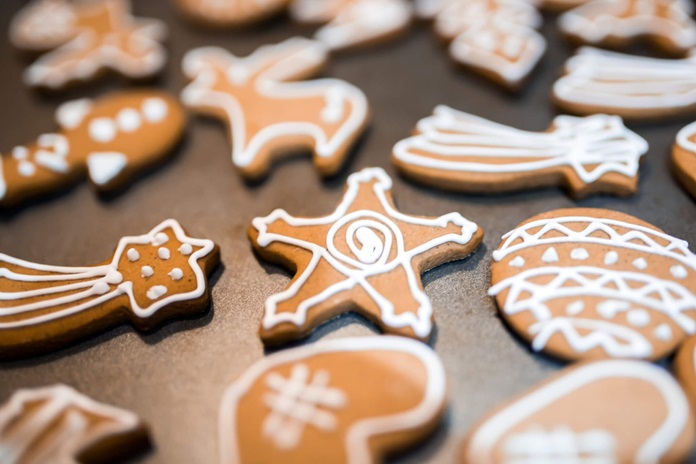Every year on November 21, we celebrate National Gingerbread Cookie Day. It’s a great time to get into the holiday spirit since the season is coming soon. Gingerbread cookies are delicious and always make us feel warm and cozy. Their rich flavor makes you want to keep eating them. While gingerbread cookies come in many shapes and sizes, the gingerbread man cookies are the most popular.
History of National Gingerbread Cookie Day
Gingerbread has a long history, dating back to Ancient Greece and Egypt, where it was often used in ceremonies. In the 11th century, crusaders introduced ginger to Europe from the Middle East.
It wasn’t until the 16th century that gingerbread cookies shaped like figures appeared. Queen Elizabeth I of England famously had gingerbread figures made to resemble foreign dignitaries and important guests, which she later presented as a special treat.
Moreover, in England during the 17th century, gingerbread biscuits were sold in monasteries pharmacies, and farmers’ markets.
In Germany, particularly in places like Nuremberg and Pulsnitz, gingerbread is considered an art form. Known as Lebkuchen, these cookies have been made for over 400 years. They are often heart-shaped with names and messages written in icing.

Gingerbread is also celebrated as an art form in Torun (Poland), Tula (Russia), Pest (Hungary), Pardubice, Prague (Czech Republic), and Lyon (France). Over time, gingerbread tied with ribbons became popular at local fairs and was even exchanged as a symbol of love.
Today, gingerbread cookies are popular in many Western countries, especially during the holiday season. You can create gingerbread houses, cakes, biscuits, or just cookies, and enjoy their warm, spicy flavors throughout the holidays.
| 16th Century (Gingerbread Houses) | People decorate gingerbread houses with foil and gold leaves. |
| 1812 (Hansel and Gretel) | Gingerbread houses become a fixture in Europe with the introduction of the Hansel and Gretel story. |
| 1930s (Cookies for Santa Claus) | The tradition of leaving cookies and milk out for Santa Claus begins. |
| 2013 (World’s Largest Gingerbread House) | A club in Texas gets the Guinness World Record for having the world’s largest gingerbread house. |
7 Interesting Facts About Gingerbread
- Gingerbread Men: The tradition of making gingerbread men can be traced back to Tudor England. Queen Elizabeth I was known to have had gingerbread figures made in the likeness of her courtiers. These early gingerbread men were more decorative than edible, as they were often used as gifts or souvenirs.
- Etymology: The word ‘gingerbread’ used to mean preserved ginger.
- Gingerbread capital: Nuremberg, Germany is famous for being the world’s gingerbread center.
- Gingerbread by Catholic monks: In the past, only Catholic monks made gingerbread in Europe shaped like angels and saints.
- Life-size gingerbread house: There’s a full-size gingerbread house at the Ritz-Carlton Dove Mountain in Tucson, Arizona.
- Swedish traditions: In Sweden, you hold a piece of gingerbread, make a wish, and then break it. If it breaks into three pieces, your wish will come true.
- Symbolism and Rituals: In medieval Europe, gingerbread was often used in various rituals and celebrations. It was believed to have medicinal properties and was used to ward off illness. In some cultures, gingerbread was given as a gift to ensure good luck and prosperity.
Conclusion
In conclusion, National Gingerbread Cookie Day on November 21 is not just an opportunity to enjoy these delightful treats but also a chance to appreciate the rich history and cultural significance behind them. From ancient ceremonial use to becoming a beloved holiday tradition, gingerbread cookies have evolved into much more than a simple dessert.
Their journey through history, from the elaborate creations of Queen Elizabeth I to modern-day gingerbread houses and cookies, reflects their enduring appeal and the joy they bring to many. As we celebrate this day, let’s embrace the warmth and coziness that gingerbread cookies symbolize and continue the tradition of creating and sharing these festive delights.
Frequently Ask Question
How did gingerbread cookies evolve over time?
In the 17th century, gingerbread biscuits were sold in monasteries and markets in England. In Germany, gingerbread, or Lebkuchen, became an art form with decorated cookies often given as gifts. Over time, gingerbread houses and cookies became popular in various Western countries, especially during the holiday season.
What are some interesting facts about gingerbread?
Gingerbread men originated in Tudor England as decorative gifts. The word ‘gingerbread’ initially referred to preserved ginger. Nuremberg, Germany, is known as the gingerbread capital. In Sweden, there’s a tradition of making a wish while breaking a piece of gingerbread. There is also a full-size gingerbread house at the Ritz-Carlton Dove Mountain in Tucson, Arizona.
How has gingerbread been used in rituals and celebrations?
In medieval Europe, gingerbread was believed to have medicinal properties and was used in various rituals. It was often given as a gift to ensure good luck and prosperity.
How can I celebrate National Gingerbread Cookie Day?
You can celebrate by baking and enjoying gingerbread cookies, decorating gingerbread houses, or sharing these treats with friends and family. Embracing the tradition and warmth of gingerbread can enhance the holiday spirit.
What is the significance of National Gingerbread Cookie Day?
This day celebrates the delicious and cozy gingerbread cookie, which is often associated with the holiday season. It’s a time to enjoy the warm, spicy flavors and the rich history behind gingerbread cookies.
You may also like to read, National Apple Betty Day – October 5, 2024
